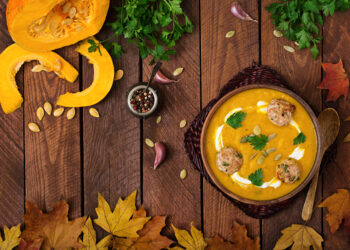Embarking on a culinary exploration of India is akin to delving into a vibrant tapestry of flavors, colors, and aromas. Indian cuisine is renowned worldwide for its diversity, complexity, and richness. From the fiery spices of the north to the coconut-infused curries of the south, each region boasts a distinctive culinary tradition that reflects its history, climate, and cultural influences.
The Melting Pot of Culinary Traditions
Indian cuisine is not just about satisfying hunger; it is a celebration of life itself. The amalgamation of indigenous spices with foreign influences over centuries has resulted in a repertoire of dishes that range from tantalizing street food to elaborate feasts fit for royalty. This fusion of flavors represents the essence of India’s culinary heritage.
Brief Overview of Indian Cuisine
A Symphony of Spices and Flavors
Indian cuisine is characterized by its liberal use of spices such as cumin, coriander, turmeric, and cardamom. These aromatic ingredients not only impart depth and complexity to dishes but also offer a myriad of health benefits. With an emphasis on balancing sweet, sour, salty, bitter, and pungent flavors in every meal, Indian cuisine stimulates all taste buds simultaneously.
Diversity in Every Bite
The vastness and diversity of Indian cuisine can be attributed to the country’s geographical expanse and cultural nuances. From tandoori kebabs in the north to fragrant biryanis in the south; from hearty lentil stews in the east to delicate seafood curries in the west—every region has its own culinary identity that reflects local ingredients and traditions.
Importance Of Breakfast In Indian Culture
The Dawn Of A New Day Begins With Breakfast
In Indian culture, breakfast holds a special place as it kickstarts the day with energy and vitality. Breakfast is considered not just a meal but an essential ritual that sets the tone for one’s day ahead. It is believed that consuming a nutritious breakfast enhances metabolism, improves concentration levels, and provides necessary nutrients for overall well-being.
A Cultural Tapestry Woven With Breakfast Traditions
The significance attached to breakfast in Indian culture transcends mere sustenance—it symbolizes warmth, hospitality, and familial bonding. Traditional breakfast items vary across different regions—the spicy masala dosa from Karnataka or fluffy pooris served with potato curry in Punjab—all reflect local tastes and customs that have been passed down through generations.

Dokla: The Fluffy Steamed Delight
Origin and History of Dokla
Dokla, a savory steamed cake originating from the Indian state of Gujarat, holds a cherished place in Indian cuisine. Its history dates back centuries, with its roots tracing to the ancient tradition of fermenting lentils and rice to create a nutritious and easily digestible dish. Over time, Dokla has evolved from being a humble household staple to a beloved breakfast item enjoyed across India and even internationally.
Ingredients Used in Making Dokla (Fermented Rice and Lentil Batter)
The hallmark of authentic Dokla lies in its simple yet essential ingredients that contribute to its unique flavor and texture. To prepare the traditional version of Dokla, one needs fermented batter made from rice flour and split chickpeas or gram flour (besan). The fermentation process not only imparts a tangy taste but also enhances the nutritional profile by increasing the bioavailability of nutrients present in these grains.
Preparation Method (Steaming Process)
The preparation of Dokla involves a meticulous process that requires patience and skill. The fermented batter is mixed with water, salt, turmeric, and sometimes ginger-green chili paste to create a smooth consistency.
This mixture is then poured into greased plates or trays and steamed until it rises like a fluffy sponge. The gentle steam ensures that the texture remains soft and airy while infusing every bite with the subtle tanginess characteristic of Dokla.
Variations of Dokla (Khatta Dhokla, Khaman Dhokla, etc.)
Dokla’s versatility shines through an array of delectable variations that cater to different palates and preferences. Khatta Dhokla stands out for its sour undertones achieved through additional fermentation or ingredients like citric acid or lemon juice.
On the other hand, Khaman Dhokla boasts a more savory profile with its use of besan instead of rice flour, resulting in a denser texture packed with spicy flavors. These diverse versions showcase the cultural richness and culinary ingenuity embedded within this beloved Indian breakfast staple.
Kaman: The Savory Accompaniment
Introduction to Kaman (spicy green chutney)
As a quintessential part of the Dokla experience, Kaman adds a burst of flavor and spice that perfectly complements the subtle tanginess of the steamed delicacy. Kaman is a vibrant green chutney that tantalizes the taste buds with its fresh and zesty profile.
It serves as a delightful condiment that enhances every bite of Dokla, creating a harmonious balance of flavors. The spicy kick from the green chilies combined with the refreshing aroma of coriander and mint makes Kaman an essential component of this traditional Indian breakfast.
Ingredients used in making Kaman (coriander, mint, green chilies, etc.)
The beauty of Kaman lies in its simplicity and reliance on fresh ingredients bursting with flavor. To prepare this delectable green chutney, you will need a handful of fragrant coriander leaves, a generous bunch of refreshing mint leaves, fiery green chilies for heat, tangy lemon juice for acidity, and a pinch of salt to bring all the flavors together harmoniously. The combination of these vibrant ingredients creates a symphony of tastes that elevate the entire dining experience when paired with Dokla.
Preparation method for Kaman
Creating this aromatic and spicy accompaniment is as simple as it is rewarding. Begin by thoroughly washing the coriander and mint leaves to ensure freshness.
Remove any tough stems from the herbs before blending them together with deseeded green chilies in a food processor or blender until you achieve a smooth paste-like consistency. Add freshly squeezed lemon juice and salt to taste, blending again until all components are well incorporated.
Transfer the vibrant green Kaman into a serving bowl ready to be enjoyed alongside your fluffy Doklas. This section not only provides insight into what makes Kaman so special but also guides readers through its preparation process step by step.
Nutritional Benefits of Dokla and Kaman
High Protein Content from Lentils in Dokla
Dokla, a traditional Indian breakfast dish, offers a significant nutritional boost due to its high protein content derived from lentils. Lentils are a powerhouse of plant-based protein, essential for muscle repair and growth.
This makes Dokla an excellent choice for vegetarians and vegans looking to increase their protein intake. The combination of fermented rice and lentil batter not only enhances the texture and flavor of Dokla but also ensures a well-rounded amino acid profile, crucial for overall health and well-being.
Rich Source of Vitamins and Minerals from Fermented Batter
The fermentation process involved in making Dokla not only adds a unique tangy flavor but also boosts its nutritional value by increasing the bioavailability of vitamins and minerals present in the batter. Fermentation breaks down complex nutrients into simpler forms, making them easier for our bodies to absorb.
This results in a higher concentration of vitamins like B vitamins (especially B12) and minerals such as iron, magnesium, and zinc in the final dish. These essential nutrients play vital roles in energy production, immune function, and overall vitality.
Antioxidant Properties of Coriander and Mint in Kaman
Kaman, the spicy green chutney that accompanies Dokla, is not just a flavorful addition but also packs a punch when it comes to antioxidant properties. The primary ingredients of coriander (cilantro) and mint bring more than just freshness to the table – they are rich sources of antioxidants like vitamin C, beta-carotene, quercetin, and flavonoids. These antioxidants help neutralize harmful free radicals in the body, reducing oxidative stress and inflammation.
Including Kaman with your Dokla not only enhances the taste experience but also provides a healthy dose of protective antioxidants for your body’s defense system. This section highlights how these traditional Indian breakfast items offer more than just delicious flavors – they provide essential nutrients that contribute to overall health and well-being.
Serving Suggestions and Pairings
Embrace Tradition: Tea or Buttermilk with Dokla
Indulging in a plate of freshly steamed Doklas, accompanied by a steaming cup of masala tea or a chilled glass of buttermilk, is a quintessential experience in many Indian households. The subtle sweetness and tanginess of Doklas harmonize perfectly with the aromatic spices in masala tea or the refreshing coolness of buttermilk. The combination not only tantalizes the taste buds but also provides a well-rounded sensory experience that reflects the diverse flavors of Indian cuisine.
Complementary Delights: Side Dishes for Enhanced Flavor
To elevate the culinary experience further, consider serving Doklas and Kamans with an array of side dishes that complement their flavors. Freshly made coconut chutney adds a creamy texture and tropical sweetness that pairs beautifully with the spongy texture of Doklas. Tangy tamarind chutney offers a tantalizing contrast to the savory notes of Kamans, enhancing their spiciness with a hint of sourness.
Additionally, crispy fried green chilies or crunchy sev sprinkled on top provide textural contrast and an extra kick of flavor to every bite. By incorporating these side dishes into your meal, you create a symphony of tastes that will leave your palate singing praises to the culinary artistry behind Dokla and Kaman.
Regional Variations: A Culinary Journey Across India
From the vibrant streets of Gujarat to the bustling markets of Maharashtra, each region in India boasts its unique take on the beloved dish, Dokla. In Gujarat, Khatta Dhokla reigns supreme with its tangy flavor profile, while Khaman Dhokla from Rajasthan offers a more savory and spicy twist. The southern state of Karnataka puts its spin on Dokla with the delectable Kotte Kadubu, a steamed delight wrapped in fragrant banana leaves.
Moving eastwards to West Bengal, one encounters the delectable Suji Kachori Dokla that combines semolina and lentils for a delightful texture and taste experience. Exploring these regional variations not only showcases the culinary diversity of India but also highlights the artistry and creativity embedded in each unique recipe.
Cultural Significance: Feasting and Festivities
In India, food is not merely sustenance; it is a celebration of life, culture, and tradition. Dokla and Kaman hold a special place in various festivals and special occasions across different regions. During Navratri in Gujarat, steaming plates of fresh Khaman Dhokla are served as offerings to Goddess Durga as part of religious rituals.
In Maharashtra, during Ganesh Chaturthi celebrations, families gather around to enjoy fluffy pieces of Khatta Dhokla as they pay homage to Lord Ganesha. The marriage ceremonies in Rajasthan are incomplete without the traditional serving of sweet-sour Gatte Ka Dhokla to symbolize harmony and happiness in marital life.
Tips for Making Perfect Doklas at Home
Troubleshooting the Texture and Taste of Doklas
Achieving the perfect texture and taste in your homemade Doklas can sometimes be a bit tricky, but fear not, as I have some expert tips to help you troubleshoot common issues. If your Doklas are turning out too dense or rubbery, it could be due to overmixing the batter or not allowing it to ferment properly. To remedy this, ensure you gently fold the batter and give it enough time to ferment in a warm environment.
On the other hand, if your Doklas are coming out too dry or crumbly, you might be steaming them for too long or at too high a heat. Adjusting the steaming time and temperature can help you achieve that soft and fluffy texture that is characteristic of a perfect Dokla.
Storage Tips for Leftover Batter or Cooked Doklas
Whether you have leftover batter or cooked Doklas that you want to save for later, proper storage is key to maintaining their freshness and flavor. If you have extra batter that you don’t plan on using immediately, store it in an airtight container in the refrigerator for up to 2-3 days. Remember to bring it back to room temperature before steaming more Doklas.
As for cooked Doklas, they can be stored in an airtight container in the refrigerator for 2-3 days as well. To reheat them, simply steam them again briefly until warmed through or microwave them with a sprinkle of water to retain their moisture.
This section aims to equip readers with practical advice on troubleshooting common issues encountered when making Doklas at home and providing useful tips for storing leftover batter or cooked Doklas effectively. By following these suggestions, aspiring chefs can elevate their culinary skills and enjoy delicious homemade Indian breakfast delicacies with confidence and ease.
Conclusion
A Culinary Journey of Delight and Health
Dokla and Kaman stand as shining examples of traditional Indian breakfast fare that not only tantalize the taste buds but also nourish the body. The fluffy texture of Dokla, steamed to perfection, combined with the zesty kick of Kaman creates a harmonious symphony of flavors that awaken the senses. Their nutritional profiles, rich in proteins, vitamins, and minerals, add to their appeal as a wholesome breakfast choice.
Celebrating Heritage Through Cuisine
Dokla and Kaman are not just dishes; they are embodiments of cultural heritage passed down through generations in India. They symbolize warmth, generosity, and the joy of sharing good food with loved ones. As we savor these delicacies, we also honor the traditions and values that have shaped Indian culinary practices over centuries.
An Invigorating Start to Your Day
Embracing Dokla and Kaman for breakfast is more than just a meal choice; it’s a celebration of flavors and nutrients that set a positive tone for the day ahead. The wholesome goodness packed into these dishes provides sustained energy and vitality, ensuring you start your mornings on a deliciously healthy note. So next time you indulge in this delightful duo, remember you’re not just eating – you’re partaking in a legacy of taste and well-being.

















